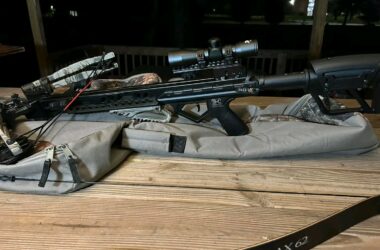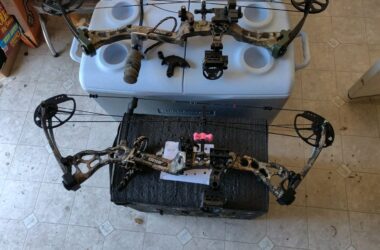A rest is a device used to assist in propelling an arrow with the string, particularly in traditional archery where no other implements are available. The use of the word “rest” assumes that the usual drawing hand holds the bow during usage (it is not held by the bow hand).
With modern compound bows, it is possible to hold at full draw and aim without holding on to any part of the bow; therefore, these devices are known as “bow cradles” or simply “cradles.” A bow cradle that attaches directly to the riser is called a window mount, while one that attaches via an arm attached to a mounting bracket behind it may be referred to as a plunger-style rest. Some forms of rests are used on crossbows as well.
When using a bow without the assistance of mechanical devices, it is necessary to grip the bow with at least three fingers of the hand that holds or draws the bowstring, also called “the drawing hand”. The other hand holds the arrow. This means that one side of an arrow’s nock sits under some part of the shooter’s drawing arm during its flight. To achieve this pressure-free passage, some archers use an index finger release aid, or simply their bare hands rather than a mechanical device for drawing and releasing the string—called “freelensing.” However, shooting any sort of small projectile accurately from one’s fingertips leaves much to be desired and so rests were invented to help shooters aim.
There was a time when virtually all archers used a bow with no mechanical assistance to hold the string on the let-off, but today most archery is done using compound bows or crossbows, both of which have cams and pulleys that allow the user to hold at full draw without holding on to anything attached to the bow’s riser. In fact, many shooters today do not use a rest while practicing, preferring instead to learn how to aim instinctively rather than aiming by means of a device. However, rests are still widely used in tournament settings where an accurate shot delivered from a two-fingered grip will be enough for many situations. For disciplines such as field archery and 3D archery involving multiple targets, a rest may even be more useful than 3D shooters’ bows since the latter might have to change from one target to another quite quickly and, in any case, there is no time limit.
Although recurve bows and longbows can be shot without rests (with the exception of bows with inadequate design), most archers today use devices that attach to their bow’s riser or limb bolts. Such rests fall into two broad classes: “Drop-away” and “fixed,” also known as “static.”
The simplest type is commonly called a block rest. It is simply a wooden or aluminum bar that attaches to the bow on either side of its handle via clamps or Ubolts, with an arrow shelf attached to the bottom. The shelf may be a self-supporting piece of plastic or metal, a folding metal wire arm attached to the end of the rest via a screw hinge, or even a simple groove cut in the bar itself. Most manufacturer-supplied rests are drop-aways.
The effectiveness of this type rests is determined by how well it pushes arrows from under the bow at an angle that keeps them close enough to straight for accurate flight but far enough away so as not to hit the riser. They tend to work best with bows having relatively narrow risers and heavy arrow pulls, which both provide more momentum for propelling arrows clear of the bow’s handle.



